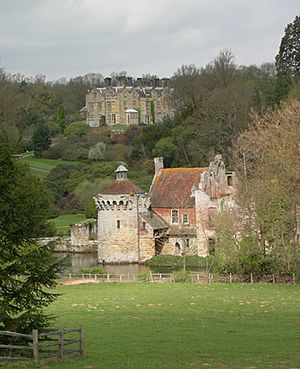River Bewl facts for kids
Quick facts for kids River Bewl |
|
|---|---|
| Physical characteristics | |
| Main source | Streams feeding Bewl Water |
| River mouth | River Teise |
The River Bewl is a river in Kent, England. It flows into the River Teise. The river starts in the Weald, which is a hilly area in Sussex. It flows through a valley that has deep cuts into red sandstone, with clay at the bottom.
Between 1973 and 1975, a large dam was built across the Bewl valley. This dam is about 900-metre (980 yd) long. It created Bewl Water, which is a big reservoir. A reservoir is like a huge lake that stores water. Bewl Water is about 30-metre (98 ft) deep and covers an area of 308 hectares (760 acres).
When there is a lot of water in the River Medway at Yalding, some of it is pumped through pipes into Bewl Water. This stored water is then used when people need more water, especially during dry times.
The River Bewl flows under the A21 road and past a historic place called Scotney Castle. Finally, it joins the River Teise at a place called Finchcocks.
Watermills on the River Bewl
For hundreds of years, the River Bewl and its smaller streams provided power for many watermills. These mills used the force of the flowing water to turn large wheels, which then powered machinery to grind grain or work with metal.
Dunsters Mill: A Unique Design
One of these mills was Dunsters Mill, located near Ticehurst. This mill is now covered by Bewl Water. Dunsters Mill was special because it was an "overdrift" mill. This means the millstones were turned from above, which is a rare design for watermills. It's more commonly seen in windmills.
When Bewl Water was built, the old mill house from the 1300s was carefully taken apart. Then, it was rebuilt in a new spot at Three Legged Cross, Wadhurst. The mill had a large wooden waterwheel that was about 12 feet (3.66 m) tall. This wheel helped power at least two pairs of millstones, which were used to grind things like grain.
Chingley Forge and Furnace: Iron Making Sites
The area around the River Bewl was also important for making iron a long time ago. Two sites, Chingley Forge and Chingley Furnace, were once busy places for this work. Both of these sites are now covered by the dam of Bewl Water.
- Chingley Forge: This forge was built between 1574 and 1589. A forge is a place where metal is heated and shaped. It was used to produce iron, making about 46 tons in one year around 1717. There is also evidence that Chingley Forge might have been a "hammer mill" even earlier, possibly in the 1200s. A hammer mill uses a large hammer powered by water to shape metal.
- Chingley Furnace: This site had a blast furnace, which is used to melt iron ore to make iron. It was built between 1558 and 1565. The furnace used an undershot waterwheel, meaning the water flowed under the wheel to turn it.
Archaeologists, who study old things, excavated these sites in 1968 and 1969. They found the remains of an old waterwheel at the furnace site, which was about 8 feet (2.44 m) tall. These discoveries helped us learn more about how iron was made in this area centuries ago.



